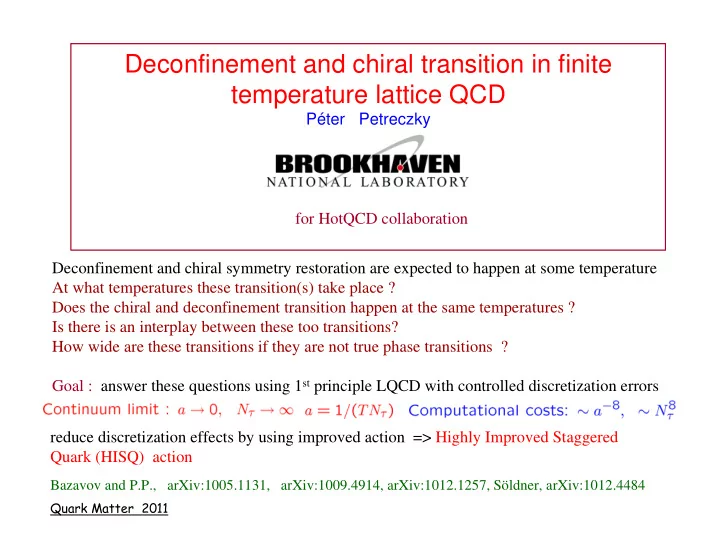

Deconfinement and chiral transition in finite temperature lattice QCD Péter Petreczky for HotQCD collaboration Deconfinement and chiral symmetry restoration are expected to happen at some temperature At what temperatures these transition(s) take place ? Does the chiral and deconfinement transition happen at the same temperatures ? Is there is an interplay between these too transitions? How wide are these transitions if they are not true phase transitions ? Goal : answer these questions using 1 st principle LQCD with controlled discretization errors reduce discretization effects by using improved action => Highly Improved Staggered Quark (HISQ) action Bazavov and P.P., arXiv:1005.1131, arXiv:1009.4914, arXiv:1012.1257, Söldner, arXiv:1012.4484 ������������������
Improved staggered fermion actions Calculations with Highly Improved Staggered Quark (HISQ) action using N τ =6, 8 and 12 lattices for, m l =m s /20 => m π ≈ 160 MeV + tree level improved gauge action => HISQ/tree HISQ/tree action removes a 2 discretization effects as well as suppresses lattice artifact related to breaking of the flavor symmetry of the staggered fermions causing non-degenerate pion spectrum. calculation with asqtad : N τ =6, 8 and 12, m π ≈ 160 MeV lattice spacing from r 1 =0.3106(20) fm
The temperature dependence of chiral condensate Chiral condensate needs multiplicative and additive renormalization for non-zero quark mass • Cut-off effects are significantly reduced when f K is used to set the scale • After quark mass interpolation based on O(N) scaling the HISQ/tree results agree with the stout continuum result !
The temperature dependence of chiral condensate (cont’d) Renormalized chiral condensate introduced by Budapest-Wuppertal collaboration with our choice d=0.15: • after extrapolation to the continuum limit and physical quark mass HISQ/tree calculation agree with stout results ! • strange quark condensate does not show a rapid change at the chiral crossover => strange quark do not play a role in the chiral transition
The temperature dependence of chiral susceptibility The renormalized 2 light flavor chiral susceptibility: • Cut-off effects are significantly reduced when f K is used to set the scale • Differences in the peak region and at low temperatures between HISQ/tree and stout results (Aoki et al, arXiv:hep-lat/0609068v2 ) are due to difference in the quark mass
O(N) scaling and the chiral transition temperature For sufficiently small m l and in the vicinity of the transition temperature: governed by universal O(4) scaling T c0 is critical temperature in the mass-less limit, h 0 and t 0 are scale parameters Pseudo-critical temperatures for non-zero quark mass are defined as peaks in the response functions ( susceptibilities) : = T c0 = = in the zero quark mass limit universal scaling function has a peak at z=z p Caveat : staggered fermions O(2) m l → 0, a > 0, proper limit a → 0 , before m l → 0
O(N) scaling and the lattice results : asqtad action The notion of the transition temperature is only useful if it can be related to the critical temperature in the chiral limit : fit the lattice data on the chiral condensate with scaling form + simple Ansatz for the regular part 5 parameter fit : T c0 , t 0 , h 0 , a t , b 1
O(N) scaling and the lattice results : HISQ/tree action the analysis uses preliminary RBC-Bielefeld data at m l =m s /40 for N τ =6 and 8 lattices
The chiral transition temperature in the continuum limit Separate and joint 1/N τ 2 extrapolations for asqtad and HISQ/tree have been performed the error budget includes difference between asqtad and HISQ/tree, O(2) vs. O(4), possible a 4 corrections in good agreement with the values obtained with stout action from chiral observables: T c = 147(2)(3)MeV, 157(3)(3)MeV, 155(3)(3)MeV, Borsányi et al, arXiv:1005.3508 RBC-Bielefeld result T c =192(7)(4) MeV ( Cheng et al, arXiv:hep-lat/0608013 ) is overestimated due to large a 4 corrections that have been neglected in the extrapolations
Quark number susceptibility and deconfinement
Polyakov loop and deconfinement The Polyakov loop describes screening properties of the medium but is not related to critical behaviour in the chiral limit low T high T cutoff effects are smaller for HISQ/tree than for asqtad and further reduced when f K is use to set the scale for HISQ/tree (but not asqtad) and agree with stout continuum result Borsányi et al, arXiv:1005.3508
Lattice results on the trace of energy momentum tensor EoS is calculated from the trace anomaly (integral method) For weakly interacting quarks and gluons: Bazavov, P.P., arXiv:1005.1131 Bazavov, P.P., arXiv:1012.1257 • HISQ results on the trace anomaly agree with previous HotQCD results for T>250 MeV • A better agreement is achieved with HRG in the low T region with the HISQ action • The HISQ results are compatible with asqtad calculations in the peak region • HISQ results agree quite well with s95p-v1 parametrization of EoS that is based on HRG+LQCD and used in hydro models Huovinen, P.P., NPA 837 (10) 26
Summary • Lattice calculations with HISQ/tree action largely reduce cutoff effects in thermodynamic quantities and make possible to get close to the continuum limit with currently available computational resources. • The chiral transition can be described in terms of universal O(N) scaling as scaling violations are small • The chiral transition defined through the chiral susceptibility is • It is necessary to define the pseudo-critical temperature in terms mixed susceptibility and specific heat to establish the width of the chiral crossover • Possible problems with T c determination are due to lack of full chiral symmetry, e.g. O(2) vs. O(4) scaling, calculations chiral (e.g. DWF) will be necessary to crosscheck the above result. • Deconfinement appears to be a rather smooth process with no well defined transition temperature. Depending on the observable it may happen at the chiral transition temperature or at higher temperatures
Recommend
More recommend